Fall 2022 Quarterly Newsletter
|
Statewide News |
Northern California |
Southern California |
Closing Out 2022 Strong
 As we look toward the holidays and the end of the year, we’re taking the opportunity to talk about how the high-speed rail program is boosting local and state economies and creating well-paying jobs. Recently, we marked more than 9,000 jobs that have been created since we started construction on high-speed rail in the Central Valley. Compare this to May 2018, a little more than four years ago, when the California High-Speed Rail Authority (Authority) achieved a major milestone with the creation of more than 2,000 construction jobs. As construction continues to ramp up in the Valley, we want to thank all the hard-working men and women and acknowledge their efforts in make high-speed rail a reality.
As we look toward the holidays and the end of the year, we’re taking the opportunity to talk about how the high-speed rail program is boosting local and state economies and creating well-paying jobs. Recently, we marked more than 9,000 jobs that have been created since we started construction on high-speed rail in the Central Valley. Compare this to May 2018, a little more than four years ago, when the California High-Speed Rail Authority (Authority) achieved a major milestone with the creation of more than 2,000 construction jobs. As construction continues to ramp up in the Valley, we want to thank all the hard-working men and women and acknowledge their efforts in make high-speed rail a reality.
In the Central Valley alone, the high-speed rail program has seen $1.7 billion in labor income and $5.4 billion in economic activity that has benefited the region and workers. Every day, we dispatch an average of more than 1,300 workers to over 30 active construction sites. Most of those workers live in the Central Valley area, which means they have opportunities to spend their dollars locally when they purchase goods and services. In Fresno alone, the unemployment rate has decreased from 17% during the Great Recession to 9.3% in 2021.
We’re also highlighting the 725 certified small businesses that are working on the high-speed rail program from across the state. Within that total are 233 certified Disadvantaged Business Enterprises (DBEs) and 87 certified Disabled Veteran Business Enterprises (DVBEs). These numbers represent all regions of the state with 252 certified Small Businesses from Northern California, 206 from the Central Valley and 235 from Southern California.
In recognition of Veteran’s Day on November 11, the Authority’s Small Business Newsletter highlighted the DVBEs that make up such an important part of the state’s business community. In this issue, we took an in-depth look at some of our DVBEs working on the project today, including Sam’s Equipment & Supplies, a DVBE providing one of the contractors in the Central Valley with construction equipment and rentals of large concrete k-rail utilized for traffic control at various closures for construction.
To get a look at the latest on construction, check out our Fall Construction Update and the latest presentation to the Authority’s Board of Directors from our November Board meeting.
Developing Station Communities
 The California High-Speed Rail Authority has made significant progress in our station planning efforts over the last year and are partnering with cities across the state to ensure that our future high-speed rail stations will serve as more than just a train stop – they will transform cities, create community hubs and serve as state icons. Our system will integrate with existing stations in San Francisco, San José and Los Angeles, bringing high-speed rail into the heart of these cities and connecting to local and regional transit systems.
The California High-Speed Rail Authority has made significant progress in our station planning efforts over the last year and are partnering with cities across the state to ensure that our future high-speed rail stations will serve as more than just a train stop – they will transform cities, create community hubs and serve as state icons. Our system will integrate with existing stations in San Francisco, San José and Los Angeles, bringing high-speed rail into the heart of these cities and connecting to local and regional transit systems.
Station design for us begins with a focus on creating shaded, walkable and bikeable station sites. Our design is primarily focused on access and putting parking in logical, but not prominent, places. We have been working with partners in the proposed station areas to implement a vision that will include convenient transit, bicycle and pedestrian connections between the station and surrounding communities.
In the Central Valley, where we have 119-miles under construction, we have awarded a contract to begin design work on a Kings/Tulare regional station and stations in Merced, Fresno and Bakersfield. The Valley is home to more than three million residents and continues to be one of the fastest growing regions in the state, and we want the Merced to Bakersfield system to provide rail service to communities with no appealing option for long distance travel other than driving. Throughout this process, we’ve attended local events such as the 559 Night Market in Fresno to hear directly from community members what they want to see around our stations. We’ve heard a lot of positive feedback from residents about how important this effort is to them and we’ll continue to engage with the public as station work advances to make sure that these stations reflect the character and priorities of those communities.
ICYMI – Jobs, Construction, and Progress: California High-Speed Rail
To celebrate the milestone of 9,000 construction jobs created, the California High-Speed Rail Authority released a video highlighting the progress made so far in delivering the nation’s first high-speed rail system. With 119 miles of construction already underway, we’re building the future of clean-air transportation in the state. We’re rapidly finishing new structures and, in the process, we’ve already created thousands of construction jobs and employed hundreds of small businesses. Check out the video below.
To stay up to date with the Authority, follow our Twitter, Facebook, Instagram and LinkedIn pages.
| NORTHERN CALIFORNIA NEWS |
A Conversation with MTC’s Therese McMillan
California High-Speed Rail Authority Northern California Regional Director Boris Lipkin and Metropolitan Transportation Commission (MTC) and the Association of Bay Area Governments (ABAG) Executive Director Therese McMillan reflect on McMillan’s career, her national and regional contributions advancing transportation planning, and the MTC’s efforts to develop a long-range vision for the Bay Area that includes high-speed rail.
McMillan, also MTC-ABAG Executive Director, will retire from both positions at the end of January 2023. With a career spanning over three decades of public service, she has guided transportation policy at the local, regional and federal levels, establishing a record of effective and committed leadership.
After joining MTC in 1984 as a transportation planner, McMillan served in positions with increasing responsibility over the next 25 years, including nine years as MTC’s Deputy Executive Director for Policy. During this period, she was an instructor in the Transportation Management graduate program at San José State University’s Mineta Transportation Institute. In 2009, President Barack Obama appointed McMillan as Deputy Administrator of the Federal Transit Administration (FTA), subsequently serving as Acting FTA Administrator. Returning to California in 2016, she served as planning chief for the Los Angeles County Metropolitan Transportation Authority before returning to the Bay Area 2019 to accept her current roles at MTC-ABAG.
What’s Happening in Northern California
This year we passed significant milestones in bringing high-speed rail to Northern California, completing environmental clearance for both Northern California project sections. Simultaneously, work continues in delivering and maintaining electrified rail travel options in the Bay Area. Caltrain celebrated the arrival of its first electric train cars, and BART held a special Board Meeting in October that included a Hayward Maintenance Complex (HMC) tour.
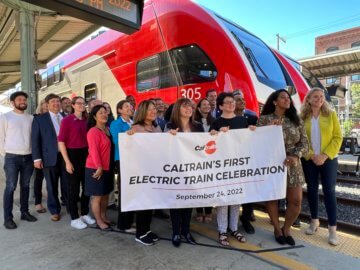 Caltrain presents new electric trains
Caltrain presents new electric trains
Caltrain held an event in September to celebrate the first public viewing of new electric train cars. Caltrain representatives were joined by federal, state, regional, and local officials at the 4th and King Caltrain Street Station in San Francisco. Congresswomen Anna Eshoo and Jackie Speier, State Senator Scott Wiener, and Assemblymembers Kevin Mullin and Ash Kalra delivered remarks. “Once high-speed rail comes along,” said Senator Scott Weiner, “We’re going to have a true regional rail system here in the Bay Area and California, and it’s long overdue.”
The new train cars or electric multiple units (EMU) are the centerpieces of the Caltrain Electrification Project, which the Authority is helping to fund. Caltrain energized track sections earlier this year and began testing the overhead electric wires to prepare for the activation of the Overhead Catenary System that will enable electrified passenger rail service.
Check out Assemblymember Ash Kalra’s message about interconnected mass transit from the event.
BART Board meeting & tour of Hayward Maintenance Complex
The BART Board of Directors treated the public to a special Board Meeting in October. Staff conducted the meeting at BART’s Hayward Maintenance Complex (HMC). The in-person proceeding centered around a tour of the facility and presentations on HMC modernization, workforce development, and an update on the Transbay Corridor Core Capacity Program.
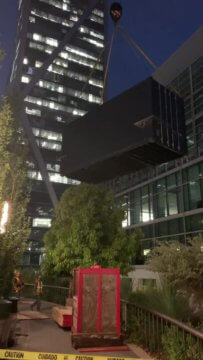
Photo: TJPA
BART officials focused on how behind-the-scenes efforts result in a better rider experience, more employment opportunities, and greater sustainability benefits. Attendees saw firsthand the work that goes into keeping trains operating effectively. Brake disks, wheels, friction brakes, logic boards, and so much more were on display, with staff on hand to answer questions.
The HMC is still growing, with a planned “Fleet of the Future Maintenance Facility,” a maintenance and engineering repair shop, and a rail car storage yard to be built on-site by 2028. The HMC is an excellent example of what to expect from future high-speed rail maintenance facilities.
More dining options for Salesforce Transit Center
In October, the Transbay Joint Powers Authority (TJPA) welcomed the latest addition to Salesforce Transit Center. Massive cranes lifted two modular containers onto the rooftop park that will house Barebottle Brewing Company at the transit center. The nationally recognized brewery will also have a space at the Center’s Grand Hall found on the ground floor facing First Street.
With more than 90% of available retail space leased, Barebottle joins many other businesses that offer services, shopping, and dining to visitors and transit riders. The sustainable building, topped by the 5.4-acre public park, features an amphitheater, gardens, trails, and children’s play space. See the Upcoming Events below for more information about holiday activities planned for Salesforce Park.
A Brief History of Rail on the San Francisco Peninsula
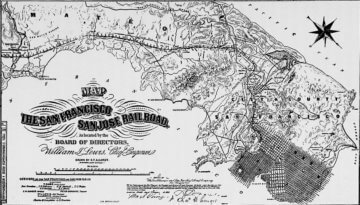
Map showing the northern section of the San Francisco and San Jose Railroad in 1862.
Back in the fall of 1851, the Daily Alta California newspaper described the proposed San Francisco and San Jose Railroad (SF&SJ) as “One of the most advantageous and necessary purposes to which we can apply our capital and industry.”
The railway had numerous false starts until San Francisco businessmen Peter Donahue, Henry Newhall, and Judge Timothy Dame incorporated the SF&SJ. They issued $2 million in stock to fund construction and completed the project in 1864.
The result was the first railroad to link San Francisco to other parts of the state. Offering passenger and freight services to San José, the rail line cut an eight-hour horse-drawn journey down to two hours and twenty minutes.
After consolidating with the Southern Pacific Railroad (SP) in 1870, the Peninsula commute service continued. SP constructed the Bayshore Cutoff in the early 1900s, bypassing a steep grade over San Bruno Mountain that reduced travel times and the railway’s length by 10.5 miles. The old right of way, known as the Ocean View line, eventually became BART’s San Francisco International Airport extension.
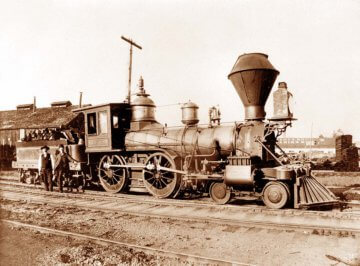
San Francisco and San Jose Railroad steam locomotive #2.
As steam engines were phased out, the first diesel-electric locomotives appeared on the Peninsula in the 1950s. The cleaner and more powerful locomotives signaled the end of the golden age of train travel in the United States. By the 1960s, competition from automobiles, buses, and a growing airline industry lowered demand for passenger rail service.
SP petitioned the California Public Utilities Commission to discontinue its Peninsula Commute service in 1977. The action prompted the State of California to take responsibility for the rail line. Shortly after, Caltrans renamed the service “CalTrain.”
The capital “T” was dropped after agencies from Santa Clara, San Francisco, and San Mateo counties formed the Peninsula Corridor Joint Powers Board (JPB). The JPB purchased the right-of-way from SP and assumed Caltrain operations in 1992. Soon after, passenger service was extended to Gilroy with six new stations, bicycle access was expanded, and trains and stations were retrofitted to accommodate passengers in wheelchairs.
The future is bright as Caltrain completes the electrification of the corridor. The improvements will provide immediate benefits with new electric trains that allow for increased service and improved travel times, noise reduction, air quality improvements, and lower emissions.
Electrification also paves the way for introducing high-speed rail service on the Peninsula. Both operators will share tracks in a blended system that will run to the Salesforce Transit Center in downtown San Francisco once the existing rail corridor is extended.
After 158 years, the rail line is recognized as the oldest continuously operating rail passenger corridor west of the Mississippi River. It remains an essential element of the Bay Area’s transportation system—connecting communities, reducing roadway congestion, and contributing to economic development.
Veteran Owned Business Demonstrates Commitment to Quality
There can be thousands of reasons for a project to fail, but there are no excuses. Organizations must define, integrate and improve processes to ensure success.
Even the most experienced project teams would find it difficult to effectively manage a complex project without individuals with in-depth knowledge and skills focused on developing capabilities and performing assessments that identify strengths and weaknesses.
Through 20 years of practice, San José-based NSI Engineering has developed strategies that help organizations sustain a culture of continuous improvement. “We don’t design or build products; we facilitate all the processes that help others design and build products successfully,” said NSI Engineering President Laura Uden. “From process improvement and tools such as root cause analysis to cultural definition and strategic planning, NSI develops systems that empower teams to achieve immediate and long-term goals.”
Before forming NSI Engineering, Uden served in the military. “I joined the Army to get money for college. It was a fair trade; some time for my country exchanged for some college funding for me. I was in military intelligence and stationed in Japan and Germany. It was very interesting work, and I learned a lot about the world,” said Uden. “I was already a physics major before I went into the Army, so I continued my degree.” After completing her service commitment, Uden left the military with the rank of Sergeant and ultimately received bachelor’s and master’s degrees in Industrial and Systems Engineering and a doctorate in Management and Management Science.

NSI Engineering President Laura Uden
Uden went on to teach industrial engineering, systems engineering and process improvement at San José State University and founded NSI Engineering in 2004 while working on a project to build a nuclear-powered spacecraft. The certified woman, disadvantaged and disabled veteran-owned small business, now employing several veterans as well as engineers and project management specialists, develops and implements solutions for various industries, including large infrastructure construction.
Uden began providing quality assurance for the high-speed rail project in 2009, writing quality management procedures, conducting audits and providing oversight for the San Francisco to San José project section.
Over the years, the company completed multiple contracts on California high-speed Rail. “We’re currently on two contracts, and we just won another that’s about to start up.” said Uden, “The new contract is in the Central Valley, and we were on a few others, including the PCM team providing oversight of the design-builder on CP 4.”
Uden is also an active Business Advisory Council (BAC) member. The BAC acts as a forum to facilitate discussion on how to increase the engagement of small businesses and ensure their equitable inclusion on the high-speed rail project.
Initially, Uden joined the BAC as an alternate in 2015, representing disabled veteran business owners. “I realized I wanted to support the group more than just attending meetings, so I decided to get involved,” said Uden. “Since I’m an engineer, I’m on the Professional Services Committee. I started as a secretary, followed by vice-chair, and now I’m currently chair.”
An engaged team that understands the importance of systems-based thinking and risk-based analysis is on a path to success. “At NSI Engineering, we provide systems engineering and project, risk and quality management services to help project teams meet requirements and improve outcomes,” said Uden.
Read more about other small businesses in the Fall 2022 Small Business Newsletter.
Frequently Asked Questions
Northern California high-speed rail staff respond to many inquiries from residents, local agencies, neighborhood groups and other stakeholders. Below are answers to some of the more common questions about the program.
Many people express support and excitement about the project and ask how they can help to advance the timeline for completion.
There are several ways to stay involved with the project. We invite everyone to check out our website. Sign up on the Contact Us page to receive our quarterly newsletter, press releases, and other alerts. For the latest construction updates, visit buildhsr.com.
Stay in touch with national organizations active in rail and transportation policy, such as the High-Speed Rail Alliance, the US High-Speed Rail Association, and the American Public Transportation Association.
Keep in contact with your elected officials. Find your congressional representative at Congress.gov and State Senate and Assembly representatives at findyourrep.legislature.ca.gov.
Get involved in I will Ride, our student education program designed to inform, educate, and inspire. Members tour active construction sites, attend presentations, network with other transportation professionals and learn about available jobs and internships.
Have any questions for the NorCal team? Please submit them to us at northern.calfornia@hsr.ca.gov.
Upcoming Events
Here are upcoming events in Northern California that you won’t want to miss!
ARTBA’s 12th Annual Student Transportation Industry Video Contest
Submission Deadline: December 2, 2022
The American Road & Transportation Builders Association (ARBTA) is hosting a student video contest. Students of all ages can get creative and show off their knowledge of and interest in transportation. Click here for more information.
Caltrain Holiday Lights Train
December 3-4
Decorated trains mark the start of the holiday season with select stops along the Peninsula that feature holiday revelry and entertainment. Attendees are encouraged to bring a gift to donate to Bay Area families in need. Click here for more information.
Napa Valley Wine Train Jolly Journeys
December 1-23
All aboard for a merry adventure through Napa Valley! Jingle and mingle in elegant railcars and enjoy the stunning views while sipping a cup of hot cider or cocoa. Click here for more information.
The Western Railway Museum Santa Train
November 26-27, December 3-4, 10-11, 17-18
The Western Railway Museum is bringing back holiday trains and transforming the museum into a holiday wonderland with activities and fun for the whole family. Click for more information.
Roaring Camp Holiday Lights Train
November 25-26, December 3-4, 12-13, 17-23
A seasonal tradition returns with the Santa Cruz Holiday Lights Train. Enjoy holiday festivities aboard vintage excursion cars adorned with thousands of colorful lights. Click here for information.
Salesforce Park Holiday Lighting Celebration
December 9
TJPA’s Salesforce Park is lighting up for the holidays. Enjoy free holiday crafts, live music, and hot cocoa while celebrating the arrival of the holiday season. Click here for information.
WinterFest at Salesforce Park
December 16-18
Enjoy festive crafts, dancing, music, and more all weekend long. Follow @transitcentersf for the latest WinterFest updates. Click here for information.
| SOUTHERN CALIFORNIA NEWS |
LaDonna’s Corner

I am Southern California Regional Director LaDonna DiCamillo and I’m excited to share the significant progress in outreach efforts and Southern California project sections. At the time of our last check-in, the California High-Speed Rail Authority (Authority) was preparing to issue the draft environmental document for the more than 30-mile Palmdale to Burbank project section. This game-changing project section will cut commute times from what may take up to two hours to something nearer 20 minutes.
The Draft Environmental Impact Report/Environmental Impact Statement (EIR/EIS) for Palmdale to Burbank was released on Sept. 2, 2022. Following an additional 30-day extension, the public comment period for the Palmdale to Burbank Project Section concludes at 5 p.m. on Dec. 1, 2022. During the 90 days, the Authority hosted several virtual and in-person events to help the public navigate the document and answer stakeholder questions. The Authority is expected to produce a final environmental report in 2023. Click here to see how to read and respond to Environmental Documents.
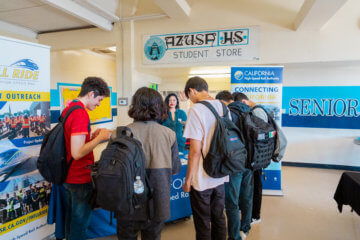 The Southern California region is now fully engaged in active educational outreach, in coordination with the Authority’s I Will Ride program. Presentations to numerous colleges and high schools are taking place this fall, culminating in an exciting ‘boots on the ground’ tour of Central Valley construction sites in early 2023. Students enjoy hearing how the high-speed rail project supports state and federal climate goals and learning about various professions in transportation and infrastructure.
The Southern California region is now fully engaged in active educational outreach, in coordination with the Authority’s I Will Ride program. Presentations to numerous colleges and high schools are taking place this fall, culminating in an exciting ‘boots on the ground’ tour of Central Valley construction sites in early 2023. Students enjoy hearing how the high-speed rail project supports state and federal climate goals and learning about various professions in transportation and infrastructure.
I’m thrilled to share the news that the Authority has been named the 2022 Employer of the Year by the Women’s Transportation Seminar – Los Angeles chapter (WTS-LA). The recognition acknowledges the Authority’s commitment to excellence, history of diversity in hiring and promotion, and its support of continuing education and professional development for employees. The award was presented at WTS-LA’s Scholarship & Awards Dinner in Los Angeles earlier this month. More information can be found at www.wtsinternational.org/chapters/los-angeles. WTS-LA supports hundreds of transportation professionals not only in Los Angeles, but throughout the Southern California region.
Stay tuned for action in the SoCal region by visiting the Authority’s website at hsr.ca.gov/high-speed-rail-in-california/southern-california/, as we progress toward regional milestones in 2023 that bring Southern Californians closer to the experience of high-speed rail.
Building Lifelong Relationships with Southern California Schools
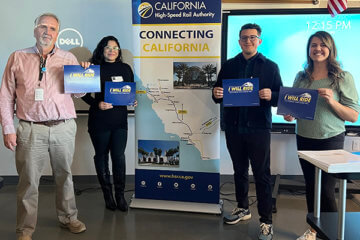
The enthusiasm for the nation’s first high-speed rail system continues to grow in Southern California and students in the region are excited to learn more about the future of the California High-Speed Rail Authority (Authority). Since the relaunch of the Authority’s I Will Ride student outreach initiative, students are discovering countless career opportunities in the 21st century with the Authority.
The Authority continued educational outreach activities in the Southern California region earlier this year following a two-year in-person hiatus due to the pandemic. Information Officer Crystal Royval conducted several in-person and virtual presentations on behalf of the Authority at schools, from kindergarten to college, throughout the Southern California region.
Workforce Development Consultant Amy Foell from the San Gabriel Valley Economic Partnership has been working closely with Royval to help bring the Authority’s outreach program to students enrolled in the Azusa, Charter Oak, Duarte and Monrovia Unified School Districts’ Career Technical Education (CTE) pathways. The CTE’s mission is to educate and train students to provide a community-sourced talent pool to sustain a healthy, balanced and local economy.
“Many of our students were not aware that such a major project was already underway in California,” said Foell. “By bringing the Authority’s outreach program into the classroom, our students have a greater appreciation for the scope of roles and responsibilities from engineers to architects. Now they can visualize an engineering career with added industry insight and confidence. As a stakeholder and collaborator, California high-speed rail has been right on time!”
The Authority is excited to continue collaborating with Foell in 2023 by coordinating the Southern California region’s first-ever student construction tour in February. Students enrolled in the CTE program at Azusa and Duarte high school, including teachers and chaperones, will travel from the San Gabriel Valley to the Central Valley. The field trip is designed to give students a firsthand look at the Authority’s active construction sites, provide a greater understanding of the statewide project and explore their interest in a career with high-speed rail.
Authority Named Employer of the Year by WTS-LA
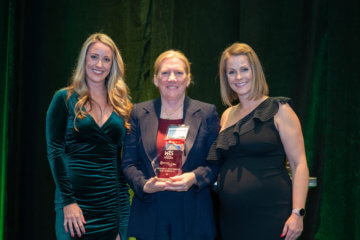 Each year, the Women’s Transportation Seminar – Los Angeles chapter (WTS-LA) recognizes an employer that supports their organization and mission, is involved with local and/or international chapters, whose organizational structure supports women in key roles, offers professional development opportunities and encourages female students to pursue careers in transportation through internship offerings.
Each year, the Women’s Transportation Seminar – Los Angeles chapter (WTS-LA) recognizes an employer that supports their organization and mission, is involved with local and/or international chapters, whose organizational structure supports women in key roles, offers professional development opportunities and encourages female students to pursue careers in transportation through internship offerings.
Southern California Regional Director LaDonna DiCamillo accepted this year’s award on behalf of the Authority at WTS-LA’s Annual Scholarship & Awards Dinner in Los Angeles earlier this month. The award recognizes the Authority’s women-led leadership throughout many major key initiatives and programs within the Authority’s high-speed rail project and its commitment to cultivating a diverse and inclusive workforce that is empowered to grow and develop as professionals.
From new and ongoing construction, diligent environmental impact studies and reports, new partnerships and the strengthening of existing ones, to the return of in-person outreach across the state – the Authority has been busy throughout 2022 bringing the nation’s first high-speed rail project to life here in the Golden State. The Authority is grateful to WTS-LA for the 2022 Employer of the Year honor and looks forward to continued progress in bringing an environmentally sustainable and safe high-speed rail system to the people of California.
Palmdale to Burbank High-Speed Rail – A Transportation Game Changer
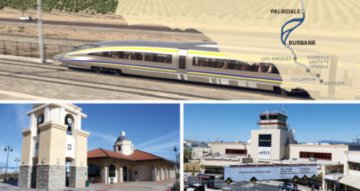 The California High-Speed Rail Authority (Authority) released a Draft Environment Impact Report/Environmental Impact Statement (EIR/EIS) for the Palmdale to Burbank project section on September 2, 2022. The Draft EIR/EIS designates the State’s Preferred Alternative, SR14A, an approximately 38-mile-long route that could transport riders from the Antelope Valley to the San Fernando Valley at speeds designed to support a proposed 13-minute non-stop trip as part of the Authority’s 800-mile statewide system.
The California High-Speed Rail Authority (Authority) released a Draft Environment Impact Report/Environmental Impact Statement (EIR/EIS) for the Palmdale to Burbank project section on September 2, 2022. The Draft EIR/EIS designates the State’s Preferred Alternative, SR14A, an approximately 38-mile-long route that could transport riders from the Antelope Valley to the San Fernando Valley at speeds designed to support a proposed 13-minute non-stop trip as part of the Authority’s 800-mile statewide system.
Currently, the one-way commute to the Los Angeles Basin from the Palmdale/Antelope Valley area is one of the longest in Southern California at one and a half hours. An all-electric high-speed rail running from Palmdale to Burbank will be a transportation game changer for these communities.
The Preferred Alternative for the Palmdale to Burbank project section is designed to connect the cities of Palmdale and Burbank through two high-speed rail stations – at the Palmdale Transportation Center, (approved in Bakersfield to Palmdale project section), and in Burbank at the Burbank Airport Station (approved in Burbank to Los Angeles project section).
Upon completion, the Palmdale Transportation Center will bring economic development to the area with high-speed rail connections to existing and planned Metrolink stations, and a connection opportunity to San Francisco, Las Vegas and Los Angeles. The swift high-speed rail trip is achieved by constructing up to 28 miles of tunnel using portions of the existing Metrolink right-of-way in the San Fernando Valley and dedicated high-speed rail tracks along the existing Metrolink/Union Pacific corridor to Burbank. The train will enter the Burbank Airport Station underground within walking distance of the Hollywood Burbank Airport Replacement Terminal creating the first air to high-speed rail connection in the United States.
Features of the system include enhanced performance and safety using positive train control, intrusion barriers and warning systems, including early earthquake warning. Regional benefits from high-speed rail will also be a game changer for climate concerns. Reducing long-distance travel by car and traffic congestion and replacing this long-distance commute with a zero-emission electrified rail will improve air quality for the region.
The draft environmental document for this segment is available for California Environmental Quality Act and National Environmental Policy Act public review through December 1, 2022.
Planning for an Environmentally Sound Future

 Keith Cooper launched Environmental Review Partners, Inc. (ERP), his Los Angeles-based environmental planning firm, in February 2021 with 24 years of experience. “I had risen as far as I could rise in [my former firm], and I wasn’t interested in doing a lateral move to another organization,” said Cooper. “I was looking for the next challenge. I just woke up one day and realized ‘Wow, I’m in the perfect position to go out on my own.’”
Keith Cooper launched Environmental Review Partners, Inc. (ERP), his Los Angeles-based environmental planning firm, in February 2021 with 24 years of experience. “I had risen as far as I could rise in [my former firm], and I wasn’t interested in doing a lateral move to another organization,” said Cooper. “I was looking for the next challenge. I just woke up one day and realized ‘Wow, I’m in the perfect position to go out on my own.’”
Starting his own firm was challenging. “I am a disabled veteran and a minority,” Cooper noted. “You hear about these participation requirements for DVBE, DBE and even SBE. It certainly gives you a leg up, but the real challenge is getting into a position to submit a bid.” He struggled to get support from the Small Business Administration. “I understand now they don’t want to throw good resources after a firm that’s not going anywhere, but they wanted me to get to a point to where I really didn’t need them before they would help.”
Cooper also missed the support staff at his former firm, ICF. He does all his own paperwork, including prework for bid and development, invoicing and Federal Acquisition Regulation compliant accounting. “You just can’t use QuickBooks, unfortunately,” said Cooper.
Cooper worked with the California High-Speed Rail Authority (Authority) at ICF, so it made sense to stay on the Los Angeles to Anaheim project section. It took longer than expected to get under contract and receive revenue, but “cash flow is pretty quick compared to other clients… [the Authority] has been a big help.”
Read more about ERP and other small businesses in the Fall 2022 Investing in California Small Businesses newsletter.
Frequently Asked Questions
Southern California high-speed rail staff respond to many inquiries from residents, local agencies, neighborhood groups and other stakeholders. Below are answers to some of the more common questions about the program.
What information can you share with residents who might be impacted by the project?
The California High-Speed Rail Authority (Authority) recognizes that private property owners will be affected by the proposed construction of the high-speed rail system and is committed to doing everything it can to educate, inform and working collaboratively with affected property owners. The Authority’s Right-of-Way program was created to provide the latest information.
The Authority’s right-of-way process documents can be found at hsr.ca.gov/programs/private-property/. These factsheets provide an at-a-glance reference for frequently asked questions and an overview of the procedures for acquiring property, the right-of-way process and the Permit-to-Enter process.
Where can more information about the environmental documents and the Palmdale to Burbank project section be found online?
The Draft Environmental Impact Report (DEIR) and project section materials – including fact sheets, maps, information stations and videos – can be found at www.meethsrsocal.org and also on the Palmdale to Burbank project section webpage. The public comment period on the Palmdale to Burbank Project Section ends at 5 p.m. on Dec. 1.
Do pedestrians have access to the train corridor in this plan?
The Authority is committed to safety on trains and surrounding train lines. The high-speed rail system will use grade separations and fencing, to the extent feasible, to isolate our operations from pedestrians and vehicles. Learn more about the many safety features on the planned 800-mile system at hsr.ca.gov/wp-content/uploads/2023/01/Safety-Factsheet.pdf.
Have any questions for the SoCal team? Please submit them to us at southern.calforni@hsr.ca.gov.
Quarterly Newsletter Archive
- Winter 2024 All Aboard Newsletter
- Fall 2023 All Aboard Newsletter
- Summer 2023 All Aboard Newsletter
- Spring 2023 All Aboard Newsletter
- Winter 2023 Quarterly Newsletter
- Fall 2022 Quarterly Newsletter
- Summer 2022 Quarterly Newsletter
- Spring 2022 Quarterly Newsletter
- Winter 2022 Quarterly Newsletter
- Fall 2021 Quarterly Newsletter
- Summer 2021 Quarterly Newsletter
- Regional Newsletter - May 2021
- Regional Newsletter - February 2021
- Regional Newsletter - November 2020
- Regional Newsletter - August 2020
- Regional Newsletter - June 2020
- Regional Newsletter - February 2020
- Regional Newsletter - November 2019
- Regional Newsletter - August 2019
The California High-Speed Rail Authority makes every effort to ensure the website and its contents meet mandated ADA requirements as per the California State mandated Web Content Accessibility Guidelines 2.0 Level AA standard. If you are looking for a particular document not located on the California High-Speed Rail Authority website, you may make a request for the document under the Public Records Act through the Public Records Act page. If you have any questions about the website or its contents, please contact the Authority at info@hsr.ca.gov.



